How and when did Neapolitan cuisine, probably most epitomized by pasta and tomato sauce, become the symbol of Italian cooking? It certainly wasn’t early on, as tomatoes didn’t become a widespread part of local cooking until, really, the mid-1800s. And in Naples, it’s still not really the standard. In popular culture this was perhaps best demonstrated in an episode of The Sopranos, where Paulie goes to visit his family’s roots in Naples, can’t find the dishes he thinks of as traditional, and the pastas he’s served are ones that he more or less finds revolting to his sensibilities. Topping that, the locals make fun of him for his idea of macaroni with “gravy”, as my New Jersey Italian friends would call it, calling him out as a “classless piece of shit”.
Yet, this myth remains, propped up the descendants of Neapolitan immigrants who created an entirely new Italian-American cuisine, and then, as Edmund White put it in a column on the history of these recipes: “much of what we consider to be authentically local, regional, or national, rests on small acts of self-deception and selective memory, the endless making and remaking of myths”. Many if not most Italian cookbooks written in Italy and in Italian back in those days, don’t even mention the combination of pasta with red sauce. Yet somehow, over time, “Neapolitan Sauce” or “Napoli Sauce” has come to refer to a fairly basic marinera – canned tomatoes (or tomato passata), garlic, basil, salt, and a pinch of chili flakes.
I was in the mood for a plate of spaghetti, and I randomly pulled a couple of my older American cookbooks off the shelf, just to see what they might offer up. Fannie Merritt Farmer is best known for her famous The Boston Cooking-School Cook Book, but over her years of writing and teaching, she wrote eight cookery books, including the one I have on my shelf, A New Book of Cookery, written in 1912 – as Tolkein would say, eleventy-one years ago (still the best way of all to express the numbers from 110-119). In this book, she explores global cooking, purporting to cover “the whole range of cookery” in 860 recipes.
This is a book that starts with a refreshing “Hawaiian Five o’Clock Tea” in which canned pineapple is cubed and simmered in its own syrup with even more added sugar, and then three cubes are dropped into your hot black tea. It finishes off with a “Dutch Salad” of green tomatoes, cucumbers, onions, cabbage, cauliflower, and green peppers in a dressing made from boiled vinegar infused and thickened with brown sugar, flour, mustard, salt, and turmeric. Flipping through the pages, it’s not the sort of food I think we tend to envision when we think of lunch or dinner in the US a century ago.
There are two spaghetti recipes included in the section on Cereal, Cheese, and Vegetarian Dishes, along with three macaroni dishes. The latter include “Virginia style” which is basically mac ‘n cheese; a siimilar recpe adding in “chipped beef”, a smoked, dried beef; and in peanut sauce of all things – made with peanut butter and milk, topped with breadcrumbs and baked. But, it’s the former recipes I was after. The first, just labeled “Italian Spaghetti”, gives us the ins and outs of pasta cooking, and serves up the strands covered over by a sauce made from simmering canned tomatoes, onion, diced porkchops, and paprika for two and a half hours. The second, and the one I made, is called “Napoli Spaghetti” and… away we go.
We have our spaghetti, obviously, along with bacon, tomatoes (canned was recommended but I didn’t have any on hand, so I just chopped these up coarsely), onion, a whole lot of tomato paste in contrast to how it’s usually used, smoked bacon, and a fascinating array of spices – salt, pepper, allspice, mace, cayenne, and bayleaf.
Finely dice the bacon and render it in a pan.
Add diced onion and tomato, along with the tomato paste and spices. Now, it’s not the way I’d tend to layer the flavors and cook things out – I’d probably have put the onion in earlier, to soften it and lightly color it, then added the tomato paste and cooked that in, and only then the tomatoes and spices, but I wanted to follow the recipe as close as I could. It’s then cooked over low heat for fifty minutes. Because I used fresh tomatoes which didn’t have all the juice typically in the can, I added some water to this so it wouldn’t burn as it cooked down.
Now, the instructions also call for cooking the spaghetti for at least twenty minutes, to make sure it’s completely soft. I don’t know if the quality and texture was just different way back then, or if they just wanted their pasta falling apart, but I didn’t cook it that long. I did cook it a little past my usual al dente, just to be in the spirit of things. The next instruction is to simply mound the hot boiled spaghetti over a plate coated with good olive oil.
And then, top it with the sauce. One then mixes it up while eating, coating the strands of pasta with both olive oil and sauce. It seems like a weird way to do it all, but then, maybe that part was all about presentation. A bowl of pasta with sauce ladled over the top does hit a nostalgic chord, even if it’s not the usual Italian approach to serving pasta. And I think I’d want to toss the spaghetti in the olive oil at the least, so it doesn’t stick. So be it, these were her instructions.
And you know what? It was damned good. Surprisingly damned good. I mean, what’s not to like? The mix of spices, while not those that today we think of as being part of a tomato sauce, were acutally pretty traditional in dishes a hundred years ago. And they’re certainly used in various ragus and sugos that are used with pastas and meat dishes in modern Italian cooking. So perhaps her Napoli Sauce is not all that far off the mark for the time. I’d certainly make and serve this again – just making some adjustments for cooking times and probably tossing the pasta with the sauce before serving. Or, maybe not. It does look pretty this way. I might even go back and try making “Italian Spaghetti”….
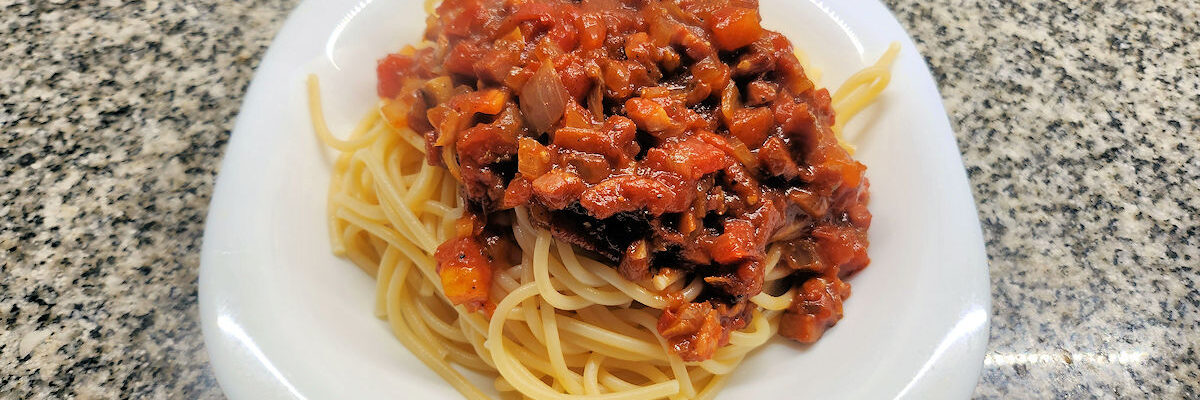
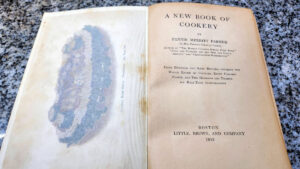
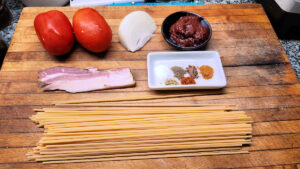
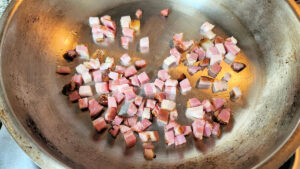
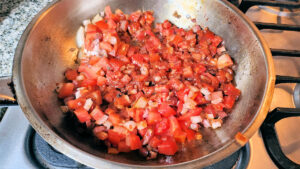
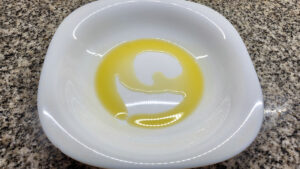
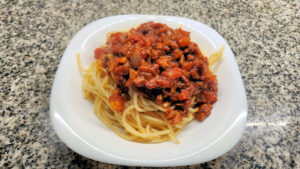
That looks just like the spaghetti I grew up eating. Without the bacon and pork chops, of course. But with mushrooms.
Ours would have been ground beef in place of the bacon and pork chops. What was different, and, as we commented elsewhere, about this one was the unexpected mix of spices.